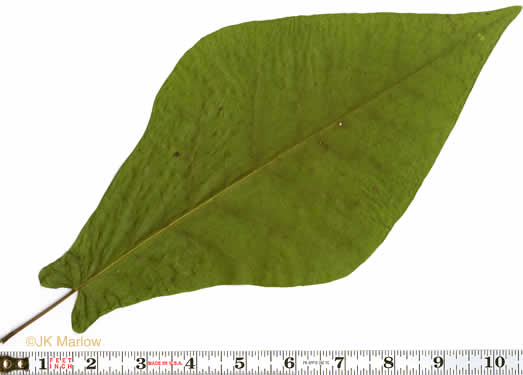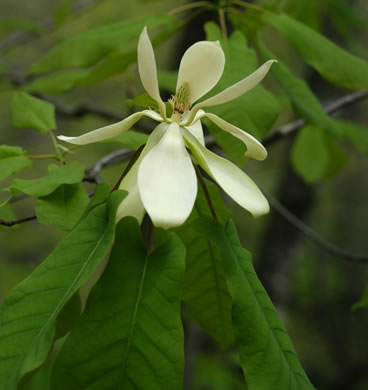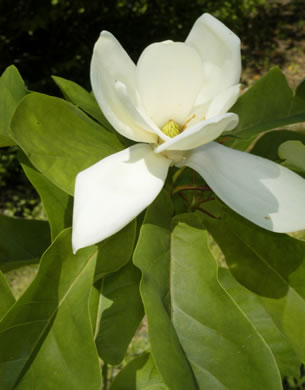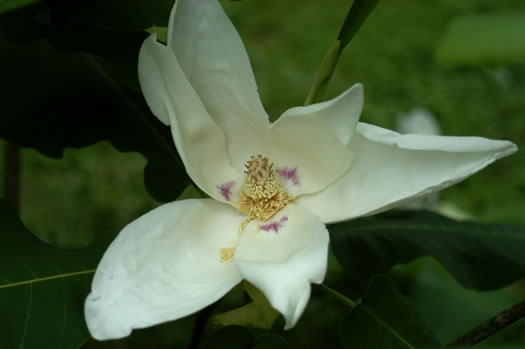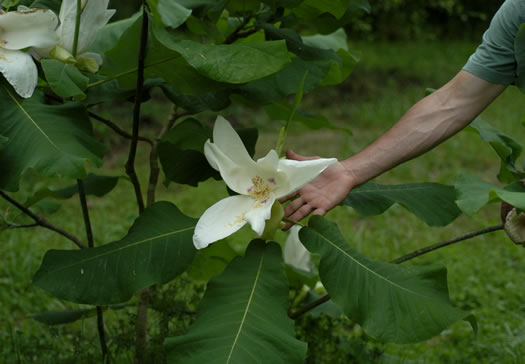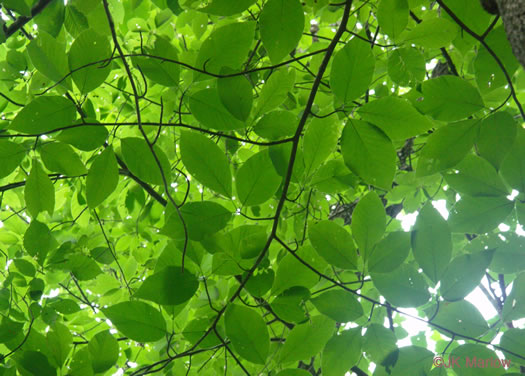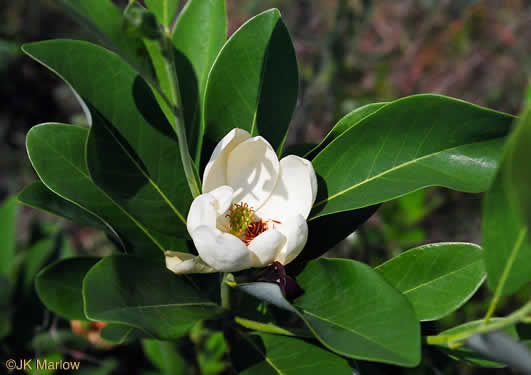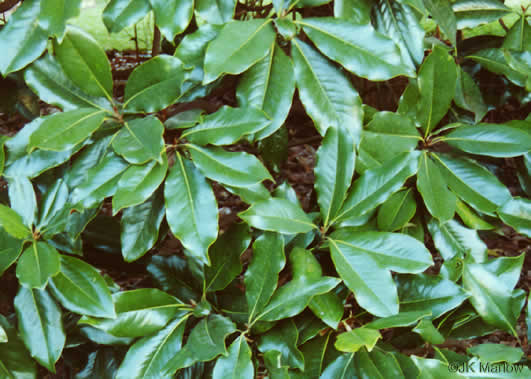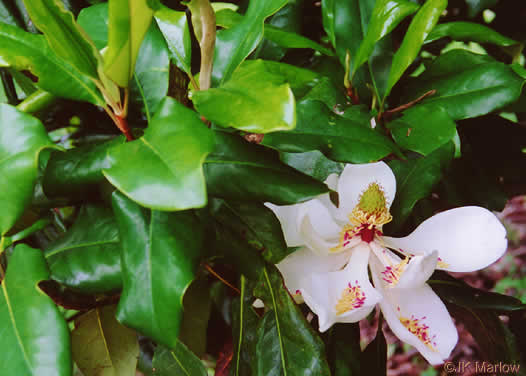South Carolina's Native Magnolias
by Richard B. Figlar*
Reprinted from the January 2007 Journal of the South Carolina Native Plant Society, and used by permission.
To see pictures or additional information about a particular plant, click its name.
It might be surprising for many South Carolinians to learn that our state is host to seven species and two varieties of Magnolia.
Worldwide, there are around 220 species, with most being native to SE Asia — from Japan & Korea through eastern and south China, then southward through the Malay peninsula and the islands eastward to Papua New Guinea. The rest are indigenous to eastern and SE North America, into some of the Caribbean islands, Mexico and Central America, on into northern South America. In reality, these numbers and wide range are misleading, as a vast majority of the world's Magnolia taxa are in rare and endangered status in most of those countries, including 3 of our own South Carolina Magnolias.
Our SC magnolias can roughly be divided into 3 groups:
- Umbrella magnolias,
- yellow-flowering magnolias (both deciduous), and
- evergreen magnolias.
Umbrella magnolias get their name from the false whorls of leaves that are produced at the branch tips in early spring, imparting an umbrella-like appearance. The umbrella magnolias include Fraser magnolia (Magnolia fraseri), pyramid magnolia (M. pyramidata), umbrella magnolia (M. tripetala), and big-leaf magnolia (M. macrophylla).
The most common of these, Magnolia fraseri, is endemic to the southern Appalachians, and is common in forests along the foothills and mountains of Pickens, Oconee and Greenville counties. A medium to large tree associated with Tuliptree (Liriodendron tulipifera), Chestnut Oak (Quercus montana) and other cove hardwoods, M. fraseri distinguishes itself by its large kite-shape leaves up to 12 inches long, with auriculate leaf bases. In mid-spring (usually April), large (up to 9-inch diameter) fragrant white flowers appear. These are conspicuous from a distance, but blooms are seldom low enough on the tree for us to enjoy the delightful and different floral scent.
The pyramid magnolia, Magnolia pyramidata, is a rare and local native to rich ravines of the coastal plain from SC to TX. It is essentially a miniature version of M. fraseri, with leaves and flowers roughly two thirds the size of those of its larger cousin. The two are closely related, and M. pyrimidata is often considered a variety of M. fraseri. In South Carolina, M. pyramidata is very rare (S1 — critically imperiled), occurring in no more than a half-dozen populations of a few individuals each in Aiken, Calhoun and Richland counties. A few years ago one of the populations in Aiken county was extirpated by beavers, and in Richland county there was only one known plant in 1985! Unfortunately, both M. fraseri & pyramidata — unlike most magnolias — are difficult to grow in cultivation.
Magnolia tripetala, or umbrella magnolia, is represented in the southeastern US (including SC) in scattered populations that are often widely separated. This small, sometimes multi-stemmed, tree resembles M. fraseri, but with much larger leaves (to 20 inches long) that are tapered at the base (no "ear-lobes"). Its large white flowers (to 11 inches) appear in late April and have a scent that might be considered disagreeable, especially at close range. Interestingly, M. tripetala is more closely related to 3 eastern Asian magnolia species than to the other American species. Umbrella tree occurs sparingly in only a handful of Piedmont counties, where it grows in rich woods along streams. It occurs most frequently in and around York County. Good populations can be found in Kings Mountain State Park. Our native M. tripetala is easily cultivated and a desirable ornamental.
Big-leaf or cowcumber magnolia, Magnolia macrophylla, bears the largest leaves and flowers of any North American tree. The distinctive white-backed leaves are often up to 32 inches long, and the late spring blooms can measure up to 20 inches across. The small purple markings at the base of the flower tepals are another unique feature. Found in scattered populations throughout Southeastern US, M. macrophylla is very rare in SC, with only two small viable populations left in York County. SCNPS member Charlie Williams had a hand in discovering both of these as recently as a few years ago. Its rarity in SC is related to, in part, its preference for calcareous or circum-neutral soils, which are relatively uncommon here. While its risk status in SC is shown as S?, it's most likely critically imperiled (S1). Big-leaf magnolia makes a spectacular ornamental and is fairly easy to grow in cultivation.
The yellow-flowering magnolias consist of cucumbertree, Magnolia acuminata, and yellow cucumbertree, M. acuminata var. subcordata.
Cucumber tree (Cucumber magnolia), the most widespread magnolia species in North America, is an uncommon component of our rich mountain and piedmont forests in the western half of the SC. It is most abundant in northern Pickens County and can be seen frequently along the Palmetto Trail at Table Rock State Park. M. acuminata differs considerably from the other SC magnolias, with its much smaller yellow or yellow-green flowers that occur in early April. These frequently go unnoticed since they are often produced high in the canopy, and the color tends to blend with the yellow-green foliage of early spring.
Southeastward, M. acuminata transitions to var. subcordata, yellow cucumbertree, a smaller tree with generally brighter yellow flowers. M. acuminata var. subcordata has a curious history. Discovered in 1790 by Andre Michaux near Augusta, GA, it was introduced into cultivation in western Europe shortly thereafter. Meanwhile, for the next 100 years or so, it seemed that this taxon had met the same fate as Franklinia alatamaha. It appeared to be extinct in its home range. Finally in 1913 it was re-discovered about 18 miles north of Augusta — not far from Stevens & Turkey Creeks where it can occasionally be seen today growing on the bluffs of those two rivers. Still, it is a very rare taxon in SC, probably of S2 or S3 risk status, occurring in only about 8 Piedmont counties. Almost all plants of yellow cucumbertree in commerce are derived from Michaux's original collection. Both varieties of M. acuminata are easy to cultivate.
The two evergreen magnolias, Magnolia virginiana (sweetbay magnolia) and M. grandiflora (southern magnolia or bull-bay) are both coastal plain species.
Magnolia virginiana is a shrub-like, often multi-stemmed, small tree common to the acidic swamps, bogs, pocosins, and other moist soils of the coastal plain east of the fall line. It is easily our most common magnolia and, in fact, ditching along roadsides actually has benefited this species by providing suitably moist habitats for it. From the Savannah River valley westward through the Gulf States, sweetbay is represented by M. virginiana var. australis, which grows into a much larger, single bole tree. Both varieties produce very fragrant, small (4 inch) white flowers from May to July. The silver backed leaves are particularly noticeable when exposed by a gust of wind.
We are all familiar with our other evergreen species, southern or big flower magnolia, M. grandiflora, and so is much of the rest of the world. In fact, southern magnolia is very likely the most cultivated and admired American tree on the planet. Native to maritime forests and rich slopes of the outer coastal plain, southern magnolia has naturalized to some extent throughout other parts of SC. It was once native to all of what is now SC and to much of North America in earlier (Tertiary) times. Well-preserved fossilized magnolia leaves discovered in 15 million-year-old shale sediments at Clarkia, Idaho, were found to contain essentially the same stomatal structures and DNA as present-day Magnolia grandiflora!
Our southern magnolia, M. grandiflora, and the other SC native magnolias have been with us for a very long time. We need to work diligently to preserve and protect their habitats, if we are to continue to have these wonderful trees to appreciate.
* Richard B. Figlar has been growing and studying magnolias for 35 years and has published numerous popular and scientific papers on the subject. For the past 15 years his focus has been magnolia taxonomy, and he is responsible, along with colleague Dr. Hans Nooteboom of National Herbarium of The Netherlands, for the new classification of Magnoliaceae which is now widely used in science and horticulture.

